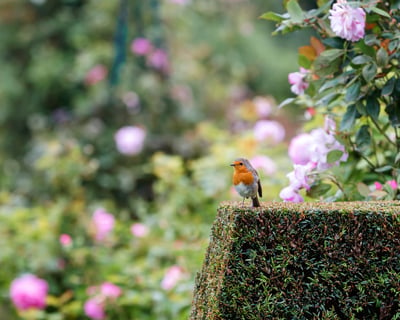Five ways to help birds in every season
The UK’s birds are in trouble, and they need our help. By following these easy steps to provide for birds year-round from RSPB expert Adrian Thomas, you and your garden can make a difference
The 2023 State of Nature report found that a sobering 43% of all UK bird species are at risk of being lost over the coming decades – the highest figure of any animal group. Gardens can be a valuable refuge for many birds, and in turn, being able to watch them brings us joy and boosts our own wellbeing.
To give our feathered friends a helping hand, follow these five simple steps for each season, with top tips from RSPB wildlife gardening expert Adrian Thomas.
1. Plant berry-rich shrubs such as hawthorn (Crataegus monogyna), elder (Sambucus nigra), Berberis or Viburnum opulus. Now is a great time to plant these bare root. Crab apples or rowans may even attract waxwings – try pink-fruited S. vilmorinii or yellow-fruited S. ‘Joseph Rock’. Bullfinches are particularly keen on Viburnum opulus berries. Consider planting these in a mixed berry-rich hedge to increase the benefits and create a structural element in your bird-friendly garden. A mixed native hedge is one of the best features you can add to your garden to benefit a wide range of wildlife, providing food, habitat and shelter.
3. Keep water available by defrosting birdbaths during cold weather.
4. Install nest boxes. In particular, try to provide for declining species such as starlings, house sparrows and swifts, with a swift box, starling box or sparrow terrace under your eaves.
5. Take part in the RSBP Big Garden Birdwatch. Gathering information about the populations and distributions of UK birds is crucial in helping inform their conservation. The Big Garden Birdwatch takes place every year on a weekend in late January; in 2025 it falls on 24-26 January.
1. Resist the urge to tidy! Leave seedheads standing for as long as possible to provide seeds and insects for birds. This will help them get through the hungry gap that coincides with the energy demands of singing, defending territories, building nests and laying eggs. Likewise, try not to be too tidy and leave some nesting material lying around – fallen leaves, twigs and moss are all important construction materials.2. Plant for birds. Try a bed of annual wildflowers – sunflowers, quinoa and cereals all provide seed for birds. Browse our plants for birds page for inspiration on what to plant to bring the most benefits for birds.
3. Make a garden pond with a shallow beach to provide a bathing and drinking spot. See our guide to creating a wildlife pond.
5. If hedges need to be trimmed, do it as early as possible, since birds such as robins, blackbirds and song thrushes start nesting as early as March. The prunings can be neatly stacked between stakes driven into the ground to create a dead hedge, which provides habitat for a variety of wildlife and even nesting sites for wrens.
1. Avoid using any pesticides. The insects that you may consider unwanted visitors are a crucial food source for the birds in your garden. For example, blue tits need a steady supply of caterpillars to feed their chicks through summer. In turn, birds will keep many insect populations under control.2. Keep a birdbath topped up. Clean it daily if possible, ideally letting it air-dry before refilling to kill pathogens.
3. Minimise use of mains water as this has a knock-on effect on wetland habitats and the birds they support. Use water butts to collect rainwater instead.
5. Dense hedges and clipped topiary provide safe hideaways for young birds as they go through the vulnerable phase of developing their adult plumage.
1. Relax with the deadheading and allow some late flowers of plants such as Echinacea, Rudbeckia and Cosmos to go to seed to provide for birds through winter. These will also provide hibernacula for insects, as well as looking beautiful in winter frosts.2. Don’t remove all your fallen leaves – when raking leaves off lawns, leave some piles under bushes where birds will be able to flick though them during winter, looking for hibernating invertebrates.
3. Leave some windfall apples scattered on the lawn to cater for ground-feeding winter visitors such as redwings and fieldfares.
5. Clean nest boxes by removing old nests so that they are ready to provide a nighttime refuge for birds when the weather turns cold.


